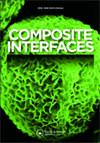Prediction of interfacial shear strength of CNT overwrapped carbon fibers using molecular dynamics and Fourier series decomposition of surface asperities
IF 2.4
4区 材料科学
Q3 MATERIALS SCIENCE, COMPOSITES
引用次数: 2
Abstract
ABSTRACT This paper aims to develop a novel approach to determining the fiber/matrix interfacial shear strength (IFSS) due to both carbon fiber roughness and the presence of carbon nanotubes (CNTs) in the matrix of a polymer composite in the form of a fiber overwrap. Under an atomic force microscope (AFM), the carbon fiber surface exhibits multi-scale asperities extending from a nanometer to several microns, likely caused by shrinkage during the graphitization process. Therefore, a Fourier series decomposition of the surface asperity data is performed to model these asperities present at various wavelengths on the fiber resulting in an amplitude and wavelength corresponding to each Fourier series term, effectively capturing the surface roughness over the entire spectrum of wavelengths. Furthermore, Molecular Dynamics (MD) simulations were performed to determine the interfacial shear strength of any subcomponent asperity of a specific amplitude and wavelength. Using MD data, governing equations were developed to compute the length-scale-averaged shear strength for a carbon fiber with any given surface asperities from the interfacial shear force for each of these subcomponent wavelengths. The results show that the presence of CNTs enhanced the IFSS by about 19% overall for a given surface asperity profile compared with the case without CNTs. GRAPHICAL_ABSTRACT利用分子动力学和表面粗糙度傅立叶级数分解预测碳纳米管包覆碳纤维的界面剪切强度
摘要:本文旨在开发一种新的方法来确定纤维/基体界面剪切强度(IFSS),这是由于碳纤维的粗糙度和碳纳米管(CNTs)在聚合物复合材料中以纤维包覆的形式存在。在原子力显微镜(AFM)下,碳纤维表面呈现出从纳米到几微米的多尺度凹凸不平,这可能是石墨化过程中收缩造成的。因此,对表面粗糙度数据进行傅立叶级数分解,以模拟光纤上存在于不同波长的这些粗糙度,从而得到对应于每个傅立叶级数项的振幅和波长,从而有效地捕获整个波长光谱上的表面粗糙度。此外,还进行了分子动力学(MD)模拟,以确定特定振幅和波长的任何子组分的界面剪切强度。利用MD数据,开发了控制方程,用于计算具有任何给定表面粗糙度的碳纤维的长度尺度平均剪切强度,这些剪切强度来自每个子分量波长的界面剪切力。结果表明,对于给定的表面粗糙度曲线,与不添加CNTs的情况相比,CNTs的存在使IFSS总体上提高了约19%。GRAPHICAL_ABSTRACT
本文章由计算机程序翻译,如有差异,请以英文原文为准。
求助全文
约1分钟内获得全文
求助全文
来源期刊

Composite Interfaces
工程技术-材料科学:复合
CiteScore
5.00
自引率
3.80%
发文量
58
审稿时长
3 months
期刊介绍:
Composite Interfaces publishes interdisciplinary scientific and engineering research articles on composite interfaces/interphases and their related phenomena. Presenting new concepts for the fundamental understanding of composite interface study, the journal balances interest in chemistry, physical properties, mechanical properties, molecular structures, characterization techniques and theories.
Composite Interfaces covers a wide range of topics including - but not restricted to:
-surface treatment of reinforcing fibers and fillers-
effect of interface structure on mechanical properties, physical properties, curing and rheology-
coupling agents-
synthesis of matrices designed to promote adhesion-
molecular and atomic characterization of interfaces-
interfacial morphology-
dynamic mechanical study of interphases-
interfacial compatibilization-
adsorption-
tribology-
composites with organic, inorganic and metallic materials-
composites applied to aerospace, automotive, appliances, electronics, construction, marine, optical and biomedical fields
 求助内容:
求助内容: 应助结果提醒方式:
应助结果提醒方式:


